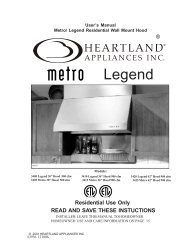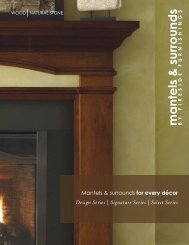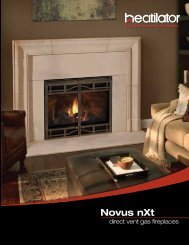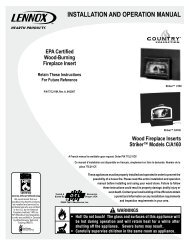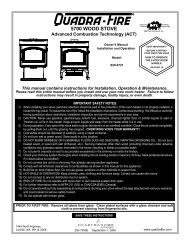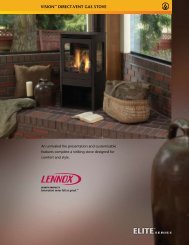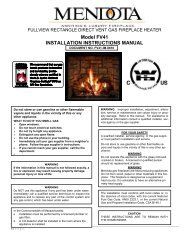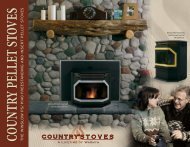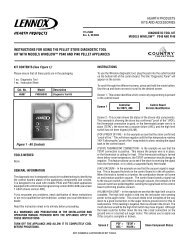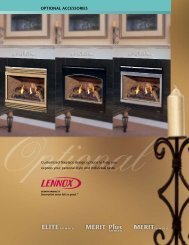Enerzone BIO-45MF Pellet Stove Manual - Inglenook Energy Center
Enerzone BIO-45MF Pellet Stove Manual - Inglenook Energy Center
Enerzone BIO-45MF Pellet Stove Manual - Inglenook Energy Center
You also want an ePaper? Increase the reach of your titles
YUMPU automatically turns print PDFs into web optimized ePapers that Google loves.
8INSTALLATIONB. VERTICALLY WITH NEW CHIMNEY SYSTEM (Refer to Figure9 – Venting through roof)NOTE: Follow Vent chimney manufacturer’s instructions.OPTION: To achieve a centered vertical installation, a 45º elbowand a clean-out tee can be used to offset the pipe from the exhaustoutlet to the rear center of the stove.OPTION: Install Vent elbow in place of clean-out tee. Locate stove.Drop plumb bob to center of tee outlet, mark point on ceiling. Installceiling support and Vent pipe per Vent manufacturer’s instructions.1. Always maintain 3” clearance from combustible materials.When passing through additional floors or ceilings, alwaysinstall firestop spacer.2. After lining up for hole in roof, cut either a round or square holein roof, always 3” larger all the way around pipe. Install upperedge and sides of flashing under roofing materials, nail to theroof along upper edge. Do not nail lower edge. Seal nail headswith flexible waterproof sealant.3. Apply flexible, waterproof sealant where the storm collar meetsthe vent. Slide storm collar down until it sits on the flashing.Seal and install cap. Mobile home installations must use aspark arrester.C. VERTICALLY INTO EXISTING CHIMNEY SYSTEMAs an alternative, 3” or 4” Vent can be run inside existing chimney totermination(Figure 11). This is the preferred method.Follow guidelines for equivalent vent length.FIGURE 9Venting through roofFOLLOW CHIMNEY ORVENT MANUFACTURER'SINSTRUCTIONSFOR BASEMENT INSTALLATIONA 4" PIPE IS RECOMMANDEDWALLSTRAPCLEAN OUTTEEBASEMENT INSTALLATIONFIGURE 10Basement installationCLEAN OUTTEEFIGURE 11Venting throughexisting chimney
11INSTALLATIONFILTERS INSTALLATION AND CLEANINGThe two filters for your convection blowers are supplied with the owner’s manual. Although the filters are not mandatory, they are useful to prevent dustfrom being dispersed into the room where the stove is located. If you install the filters, please make sure that they are cleaned on a regular basis as perour recommended maintenance schedule. This is particularly critical if you have animals in your house, such as a dog or a cat. Filters that are not cleanedcan clog up and cause your stove to overheat. You may also damage or burn the convection blowers. In order to install the filters, simply insert them inthe slot just above the blower’s finger guard. To clean the filters, use a vacuum or remove the filters and rinse them with hot water.
OPERATION 12PROPER FUELTHIS STOVE IS APPROVED FOR BURNING PELLETIZED WOODFUEL ONLY! Factory-approved pellets are those ¼” or 5/16” indiameter and not over 1” long. Longer or thicker pellets sometimesbridge the auger flights, which prevents proper pellet feed. Burningwood in forms other than pellets is not permitted. It will violatethe building codes for which the stove has been approved andwill void all warranties. The design incorporates automatic feed ofthe pellet fuel into the fire at a carefully prescribed rate. Anyadditional fuel introduced by hand will not increase heat output butmay seriously impair the stoves performance by generatingconsiderable smoke. Do not burn wet pellets. The stove’sperformance depends heavily on the quality of your pellet fuel.Avoid pellet brands that display these characteristics:a. Excess Fines – “Fines” is a term describing crushed pellets orloose material that looks like sawdust or sand. <strong>Pellet</strong>s can bescreened before being placed in hopper to remove most fines.b. Binders – Some pellets are produced with materials to holdthem together, or “bind” them.c. High ash content – Poor quality pellets will often create smokeand dirty glass. They will create a need for more frequentmaintenance. You will have to empty the burn pot plus vacuumthe entire system more often. Poor quality pellets coulddamage the auger. <strong>Enerzone</strong> cannot accept responsibility fordamage due to poor quality pellets. The pellet ash contentshould be less than 1%. The pellet grade and ash contentshould be indicated on the bag by the pellet manufacturer.PRE-START-UP CHECKRemove burn pot, making sure it is clean and none of the air holesare plugged. Clean the firebox, and then reinstall burn pot. Cleandoor glass if necessary (a dry cloth or paper towel is usuallysufficient). Never use abrasive cleaners on the glass or door. Checkfuel in the hopper, and refill if necessary.BUILDING A FIRENever use a grate or other means of supporting the fuel. Use onlythe <strong>Enerzone</strong> approved burn pot.NOTE: During the first few fires, your stove will emit an odor and asmall amount of fumes as the high temperature paint cures orbecomes seasoned to the metal. Maintaining smaller fires willminimize this. Avoid placing items on stovetop during this periodbecause paint could be affected. Make sure the room is wellventilated.Open windows. Odors and fumes released duringthis process are unpleasant but they are not toxic.FIGURE 15PC boardLIGHTING PROCEDUREa. Fill hopper and clean burn pot.b. Press “MODE” button to select the desired setting “MANUAL”or ‘THERMOSTAT”c. If the flame is too low in burn pot or the unit has difficulty tolight, reduce the air supply by turning the air supply controlknob toward the minimum setting. The knob is located on theside of the unit. Once the fire is established, adjust the airsupply knob to the desired flame height.d. Adjust feed rate to desired setting by pressing “-” or “+” button.If fire doesn’t start in 30 minutes, refer to troubleshooting section.UNIT CONTROLS (See Figure 15)The blowers and automatic fuel supply are controlled from a panelon the right-hand side of the <strong>BIO</strong>-45 MF. The control panel functionsare as follows.
13OPERATIONa. MODE SWITCH• When the mode switch is pressed, the stove will automatically ignite. If the manual mode is selected, the heat level must be selectedmanually to adjust the stove’s heat output to the desired level. If the thermostat mode is selected, the stove will automatically modulatebetween the lowest heat level and the heat level selected to keep the room temperature at the thermostat’s setting. If the set roomtemperature is achieved while the stove has been running at the lowest heat level for more than 45 minutes, the unit will automaticallyshut off and will start another ignition cycle only when the thermostat calls for heat again. No fire starter is necessary to ignite the unit.The auger will feed fuel for 4 minutes and the electronic igniter will stay on for 10 minutes. If the unit doesn’t ignite within 15 minutes,the stove will wait for 5 minutes and will start a second ignition cycle. If ignition fails a second time, a warning message will appear oncontrol panel.• The Heat Level may be selected during the ignition cycle. However, the unit will only feed fuel at the desired heat level setting when theheat sensor located into the stove will receive a signal indicating that the unit has been fully ignited. This may take anywhere between10 and 15 minutes.b. FUEL FEED SWITCH• When the “Fuel Feed” button is pushed and held down the stove will feed pellets continuously into the burn pot.CAUTION: THIS FUNCTION CAN ONLY BE OPERATED WHEN THE STOVE IS IN “OFF” POSITION. THE FUEL FEED SWITCH ISUSED TO PRIME THE AUGER WHEN AUGER IS EMPTY.c. NOISE REDUCER• The convection blower speed varies directly with the fuel feed rate.• When the “NOISE REDUCER” button is pushed, the convection blower will switch to its lowest speed. The convection blower willremain at its lowest speed unless the stove reaches a certain temperature. If this occurs, the convection blower will go back to itshighest setting to cool down the stove. The low noise button will have to be pressed again for the convection blower to go back to itslowest speed. Please note that the difference in noise level may not be noticeable on units manufactured after March 2008, (with serial#925 or above). Those units already use two ultra-quiet tubeaxial convection blowers that produce a very low noise even at full speed.d. HEAT LEVEL• By pressing “+” or “-“, you can set the pellet feed rate and hence the heat output of your stove. The levels of heat output willincrementally change and each LED indicate the level from 1 to 6.e. RESETReset button has to be used to clear any error on the control and restart your stove.OPENING DOORThe door should be open only for maintenance purposes.CONVECTION BLOWER (ROOM AIR FAN)Upon starting your stove, the convection blower will not come on until the stove’s heat exchanger warms up. This usually takes about 10 to15 minutes from start-up. Speed will vary with the selected feed rate, except if the noise reducer mode has been activated.COMBEX tmYour stove uses a unique patented technology called COMBEX. As opposed to most other pellet stoves, which useonly an exhaust blower, your <strong>BIO</strong>-<strong>45MF</strong> uses a motor on which are mounted two housings with impeller blades. Onehousing serves for combustion, and the other for exhaust. This is why we refer to the combustion/exhaust blowerthroughout this manual. The COMBEX system balances combustion air and uptake to provide clean, worry-freecombustion which is less dependent on the leak-tightness of the device and the quality of the combustible.
OPERATION 14IF THE STOVE RUNS OUT OF PELLETSThe fire goes out and the auger motor and blowers will run until the stove cools down. This will take a few minutes.After the stove’s components stop running, a warning message will appear .To restart, press the “RESET” button, refill the hopper , and press the “FUEL FEED” buttonPress the “MODE” button to start the unit on <strong>Manual</strong> or Thermostatic mode.until pellets begin to fall into the burn pot.DAMPER CONTROLThe damper control rod on the stove’s lower right side adjusts the combustion air. This control is necessary due to the varied burncharacteristics of individual installations and different pellet brands. It allows you to improve the efficiency of your stove. Providing correctcombustion air will reduce the frequency of cleaning your glass door and prevent the rapid buildup of creosote inside your stove andchimney.You should adjust the damper based on the fire’s appearance. A low, reddish, dirty fire can be improved by by increasing the air supplyusing the control knob located on the side of the unit. A “blow torch” fire can be improved by reducing the air supply.Through trial and error, you will find the best setting. Consult your dealer if you need help.REFUELINGWe recommend that you not let the hopper drop below ¼ full. If the reload lid stays for open more than 3 minutes, a warningappear. To restart, press the “RESET” button, and then press the “MODE” button to start the unit on <strong>Manual</strong> or Thermostatic mode.willKEEP HOPPER LID CLOSED AT ALL TIMES EXCEPT WHEN REFILLING. THE HOPPER MAY BE FILLED WHILE THE STOVE ISOPERATING. DO NOT OVERFILL HOPPER.SHUTDOWN PROCEDURETurning your <strong>Enerzone</strong> stove off is a matter of pressing the “MODE” control panel switch, until the “OFF” led goes on. The blowers willcontinue to operate until internal firebox temperatures have fallen to a preset level.SAFETY FEATURESa. Your stove is equipped with a re-settable high temperature switch (also called heat sensor or heat switch). The switch has a resetbutton on its backside. Like a circuit breaker, once tripped, the reset button will have to be pushed before you can restart thestove. The high temperature switch is there to protect the stove from overheating in case of an evacuation problem, a controlboard problem, a blower problem, or any other problem causing the unit to overheat. The manufacturer recommends that you callyour dealer if this occurs as it may indicate a more serious problem. A service call may be required.NOTE: If an overheating situation occurs, the high temperature switch (called the L-250 manual reset) will automatically shutdown the auger (fuel feed system) and a warning codewill appear.b. If the combustion blower fails, an air pressure switch will automatically shut down the auger and a warning message willappear. This safety feature is to prevent the unit from burning fuel when the combustion/exhaust blower has failed, thereforepreventing combustion fumes from spilling into the room.c. If the temperature in the auger rises beyond a certain acceptable level, a second high temperature switch located on the augerhousing will stop the fuel feed system and a warningwill appear.CODE BEFORE RESETING TO RESETH1, H2, H3 Heat exchanger and/or exhaust systemOR H4 is/are clogged. Refer to the owner’s manualfor maintenance procedures.Press simultaneously for 2 secondsand.*** After 3 attempts, reset is no longer possible, call SBI technical support.
15THERMOSTAT INSTALLATIONOPERATING THE STOVE USING A THERMOSTATA thermostat may help you maintain a constant house temperatureautomatically. A millivolt thermostat or 24 Volt thermostat isrequired. A fixed wall mount or hand held model can be used. Thecontrol panel can be set up two ways to operate your stove inthermostatic mode.THERMOSTAT WIRESTERMINALTHERMOSTAT INSTALLATION• Unplug the stove from the power outlet.• Connect two thermostat wires to the terminal block located onthe lower right side of the back of the stove. To do so, loosenthe two screws and insert the wires in the terminals. Tightenthe two screws. (See figure 16)• If you are using a wireless wall thermostat or a hand heldthermostatic remote control, you can locate the receiver behindthe stove’s back panel, on the right end side, just below theterminal block. Most receivers are already equipped withquick-connect terminals. Simply unplug the PC board wiresconnected to the back of the terminal block and connect themdirectly with the receiver’s terminals. Location of thethermostat is very important to obtain the best comfort andefficiency from you <strong>BIO</strong>-45 MF. The thermostat should bemounted 50 inch from the floor on a wall located 15 to 20 feetfrom the stove. You should avoid an installation directly in frontof the stove to avoid cycling.(See figure 17)MODESTHERMOSTATIC MODE• To use this mode, the “MODE” button must be pushed to“Thermostat” upon starting the stove. The heat setting is thenselected using the “Heat Level” selector “+ or –“. When set inthermostatic mode, the stove will automatically run a the heatlevel selected until the set room temperature is reached. Whenthat occurs, the stove will switch to heat setting #1 (lowest) untilthe thermostat calls for heat again. The convection blower willalso slow to its lowest speed. When the thermostat calls forheat again, the stove will increase its feed rate to match theheat setting selected.FIGURE 16Rear view• N.B.: If the room temperature remains stable and thethermostat does not call for heat during at least 45 minutes,the stove will shut down. When the thermostat calls for heatagain, the stove will start an ignition cycle. Once the ignitioncycle is completed, the stove will increase its feed rate tomatch the heat setting selected.
16THERMOSTAT INSTALLATION (continued)• N.B.: It is possible to change the setting of your unit such that ifthe thermostat does not call for heat after 45 minutes, the unitwill remain at the lowest heat setting (#1) but will not shut down(this is the PILOT ON mode). The stove will remain at thelowest heat level until the thermostat calls for heat again. If youprefer that your unit runs following that logic, you need tochange the setting to PILOT ON by simultaneously pressing thefollowing two buttons on the PC Board for a couple of seconds:andOnce you do that, the letters P, I, L, O, T, O, N will appear onthe PC Board to let you know that you are in the “PILOT ON”mode. If you wish to go back to the default thermostatic mode(i.e. the unit shuts down after 45 minutes if the thermostat doesnot call for heat), simply press the same two buttons again for acouple of seconds. The letters P, I, L, O, T, A, U, T, O willappear on the PC Board to let you know that you are in the“PILOT AUTO” mode.•NOTE: When in thermostatic mode:• You should not operate the manual control or play with thetemperature setting.SHOULD BE AVOIDEDD = MINIMUM DISTANCE 15 FEETFIGURE 17Thermostat location• YOUR THERMOSTAT SHOULD BE INSTALLED BY ANAUTHORIZED DEALER OR SERVICE PERSON.
OPERATION 17OPERATING SAFETY PRECAUTIONSPLEASE READ THIS!a. If you notice a smoldering fire (burnpot full but no visible flame) AND a heavy smoke buildup in firebox,immediately TURN OFF the stove, but DO NOT unplug it. Do not open the door, change the dampersetting or tamper with any controls on the stove. Wait until smoke inside the firebox clears and blowersshut down. Do as instructed in “PRE-START-UP CHECK” and “LIGHTHING PROCEDURE”, then attemptto restart the fire. If the problem persists, contact your dealer. Please note that smoke build-up duringignition may occur. Smoke can accumulate in the firebox for a few seconds just before the igniter is hotenough to fire-up the pellets in the burn pot. This is normal. As soon there is fire in the burn pot, smoke willdisappear.b. DO NOT STORE OR USE FLAMMABLE LIQUIDS, ESPECIALLY GASOLINE, IN THE VICINITY OFYOUR ENERZONE STOVE. NEVER USE A GAS OR PROPANE TORCH, GASOLINE, GASOLINE-TYPELANTERN FUEL, KEROSENE, CHARCOAL LIGHTER FLUID OR SIMILAR FLUIDS TO START OR“FRESHEN UP” A FIRE IN THIS HEATER.c. WARNING: DO NOT OVERFIRE THIS STOVE. This may cause serious damage to your stove and voidyour warranty. It also may create a fire hazard in your home. IF ANY EXTERNAL PART OF THE UNITBEGINS TO GLOW, YOU ARE OVERFIRING. Immediately press the “MODE” switch on the control panel,until reaching the ‘OFF’ position. DO NOT UNPLUG YOUR STOVE. If you leave your house and yourstove is not connected to a thermostat or a fresh air supply, do not leave it at the maximum setting. If theambient air in a confined room becomes to hot, the stove may overheat and the thermal protectionon the combustion/exhaust motor may be activated, causing the motor to stop.d. KEEP ALL LOOSE OR MOVEABLE HOUSEHOLD COMBUSTIBLES, SUCH AS FURNITURE, DRAPES,TOYS, ETC. AT LEAST THREE FEET FROM THE OPERATING STOVE.e. Maintain proper ventilation. It is important that adequate oxygen be supplied to the fire for the combustionprocess. Modern houses are often so well insulated that it may become necessary to open a windowslightly or install an outside air vent to provide sufficient combustion air.f. Since heating with solid fuel is potentially hazardous, even with a well made and thoroughly tested stove, itwould be wise to install strategically placed smoke detectors and have a fire extinguisher in a convenientlocation, near an exit.g. Do not open the stove door when operating unless necessary. This will create a dirty, inefficient burn andcould allow smoke spillage or sparks to escape.h. Do not permit operation by young children or those unfamiliar with stove’s operation.i. Do not service or clean this appliance without disconnecting the power cord.j. Do not abuse the door glass by striking, slamming or similar trauma. Do not operate the stove with the glassremoved, cracked or broken.k. If the stove is installed in a room without air conditioning, or in an area where direct sunlight can shine onthe unit, it is possible this can cause the temperature of the stove to rise to operational levels; one of thesensors could then make the blowers start on their own. It is recommended that the stove be unpluggedwhen not in use for extended periods of time (i.e. during the summer months).
18MAINTENANCEFAILURE TO CLEAN AND MAINTAIN THIS UNIT ASINDICATED CAN RESULT IN POOR PERFORMANCE ANDSAFETY HAZARDS. NEVER CLEAN WHEN HOT.NOTE: Inspect burn pot periodically to see that holes havenot become plugged. If so, clean thoroughly.ASH REMOVALAshes should be placed in a metal container with a tight-fittinglid. The closed container or ashes should be placed on anoncombustible surface or on the ground, well away from allcombustible materials pending final disposal. If ashes aredisposed of by soil burial or otherwise locally dispersed, theyshould be retained in the closed container until all cinders havethoroughly cooled.ASH DISPOSALThe <strong>BIO</strong>-45 MF has an ash bin located below the firebox. Toremove ashes:a. Make sure fire is out and the firebox is cool.FIGURE 18Baffle removalb. Open the door and remove the baffle from the firebox.Close the door.c. With the door closed, clean heat exchanger tubes byactivating the cleaning rod back and forth from front toback.(see Cleaning section and Figure 18 & 19) .d. Open the door and remove the burn pot by grasping it andpulling straight out. Scrape the burn pot with a scraper ifnecessary. Make sure that the burn pot holes are notplugged. Empty ashes from the burn pot into the pedestalash bin through the opening at the bottom of the firebox.Put the burn pot back in place. Make sure it is level andpushed all the way in.e. Scrape the ashes in the firebox into the pedestal ash binthrough the opening or the bottom of the firebox or vacuumto remove ashes.WARNING: Make sure ashes are cool to the touchbefore using a vacuum. See “VACUUM USE”.CLEANING RODFIGURE 19Cleaning rodf. Periodically remove and empty the ash bin (see Figure 20)by opening the front lid of the pedestal below the ash lip.Dispose of ashes properly.(See “ASH REMOVAL” above)g. Put the ash bin back into place, making sure that youtighten the knob and maintain a good seal. Inspect gasketat the same time to make sure it is in good condition.HIGH TEMPERATURESWITCH L-250MANUAL RESETHIGH TEMPERATURESWITCH F-160HIGH TEMPERATURESWITCH L-250 AUTOMATICCONVECTIONBLOWERAIR SUPPLYCONTROLFIGURE 21Side viewFIGURE 20Ash drawer
VACCUM USEMAINTENANCE 19ACCESS TOCLEANING OUTLETBAFFLEIf a vacuum is used to clean your stove, we suggest using avacuum designed for ashes.LEFT SIDE PANELOF COMBUSTIONCHAMBERSome regular vacuums and shop vacs leak ash into the room.Your vacuum or shop vac may have a special filter or bagavailable to eliminate this leakage.CLEANINGa. Heat Exchange Tubes – Your <strong>BIO</strong>-45 MF stove isdesigned with a built-in heat exchanger tube cleaner.This should be used weekly to remove accumulatedash on the tubes. To clean the heat exchanger, openthe door and grab the cleaning rod located behind thelouvers (just above the stove’s door) and push itforward. Close the door. Slide the cleaning rod backand forth two or three times from front to back (refer tofigure 19). When finished, push the cleaning rod backin, behind the louvers.b. Baffle: Remove the baffle and scrape off ashes. Usea vaccum is necessary. In some cases, you will needto remove creosote on the baffle, which canaccumulate rapidly under certain conditions. A smallwire brush can be used. It is important to remove thiscreosote because it is highly combustible and couldcause premature corrosion.c. Chamber walls: Periodically, you must vacuum theashes that may have accumulated on the main wallsof the combustion chamber. START BY REMOVINGTHE DECORATIVE MASONRY-LIKE PANELS,WHICH ARE SIMPLY HELD BY SCREWS. Scrape offashes. Use a vacuum is necessary. There is also acleaning outlet located behind the left side panel of thecombustion chamber. Remove this panel using ascrew driver. You will notice a small rectangularcleaning outlet. Inspect behind this outlet (see figure22) Insert the vacuum tip through the cleaning outletand clean thoroughly. REPEAT THIS OPERATION ATLEAST ONCE PER TON OF PELLETS BURNEDUNTIL YOU ARE FAMILIAR WITH HOW ASHESACCUMULATE WITH YOUR OPERATINGPRACTICES.SIDE DOORBOTTOM LEFTSIDE PANELACCESS PANEL TOEXHAUST BLOWERACCESS PANEL GASKETFIGURE 22Access to cleaning outlet #1FIGURE 23Access to cleaning outlet #2BLOWERSDANGER: RISK OF ELECTRIC SHOCK.POWER BEFORE SERVICING UNIT.DISCONNECT• Cleaning – Over a period of time, ashes or dust maycollect on the blades of both the combustion/exhaustblower and convection blower. Periodically, theblowers should be cleaned as the ash and dust canimpede performance. The combustion/exhaust blowercan be accessed by opening the left, right, and backpanels located on the pedestal. To clean the blades inthe combustion housing, insert the vacuum tip throughthe air inlet damper opening located on the side of thecombustion housing. Clean thoroughly. To clean theblades in the exhaust housing, use a screw driver toremove the cleaning access panel located on the sideof the metal box covering the housing. Insert thevacuum tip through the cleaning outlet and clean theblades thoroughly.NOTE: When cleaning, be careful not to bend fan blades.Some stove owners lightly spray an anti-creosote chemical onthe fire to help reduce creosote formation within the stove.HIGH TEMPERATURESWITCH L-250MANUEL RESETCONVECTIONBLOWERTHERMOSTATTERMINALPOWERCORDAIR SUPPLYCONTROLFIGURE 24Rear viewAUGERMOTORCONVECTIONBLOWERPRESSURESWITCHIGNITEREXHAUSTTHERMISTORCLEANINGACCESS PANELCOMBUSTION/EXHAUSTBLOWER MOTOROiling – both the convection and combustion/exhaust blowers have sleevebearings that are permanently sealed. No oiling is required.
20MAINTENANCECHIMNEY CLEANINGa. Creosote Formation – When any wood is burned slowly, it produces tar and other organic vapors, which combine with expelledmoisture to form creosote. The creosote vapors condense in the relatively cool chimney flue or a newly started fire or from a slowburningfire. As a result, creosote residue accumulates on the flue lining. When ignited, this creosote makes an extremely hot fire,which may damage the chimney or even destroy the house. Despite their high efficiency, pellet stoves can accumulate creosote undercertain conditions.b. Fly Ash – This accumulates in the horizontal portion of an exhaust run. Though noncombustible, it may impede the normal exhaustflow. It should therefore be periodically removed.c. Inspection and Removal – The chimney connector and chimney should be inspected annually or per ton to determine if a creosote orfly ash build-up has occurred. If creosote has accumulated, it should be removed to reduce the risk of a chimney fire. Inspect thesystem at the stove connection and at the chimney top. Cooler surfaces tend to build creosote deposits quicker, so it is important tocheck the chimney from the top as well as from the bottom.The creosote should be removed with a brush specifically designed for the type of chimney in use. A qualified chimney sweep can performthis service. It is also recommended that before each heating season the entire system be professionally inspected, cleaned and, ifnecessary, repaired.To clean the chimney, detach the vent at the combustion blower transition where it is attached to the blower.RECOMMENDED MAINTENANCE SCHEDULEUse this as a guide under average-use conditions.ComponentsDailyWeeklyor after+/- 10 bagsBurn Pot Empty Empty / BrushGlass Wipe CleanHeat Exchanger TubesActivate cleaningrod every time youload the stoveActivate cleaning rodand vacuumTwice a yearor after+/- 25 bagsAnnuallyorper ton of pelletsBaffleEmpty and brushConvection BlowerFiltersVacuumAshe DrawerEmptyCombustion Chamber Vacuum Vacuum / BrushLeft-hand ChannelVacuumExhaust BlowerVacuumPressure Switch TapBrushVenting System Inspect SweepGasketsInspectHopperEmpty / VacuumGasket around door and door glass should be inspected and repaired or replaced when necessary (see “REPLACEMENT PARTS”).REMOVAL AND REPLACEMENT OF BROKEN DOOR GLASSWhile wearing leather gloves (or any other gloves suitable for handling broken glass), carefully remove any loose pieces of glass from thedoorframe. Dispose of all broken glass properly. Return the damaged door to your <strong>Enerzone</strong> Dealer for repair or replacement. Neither theappliance owner nor any other unauthorized person(s) should replace the door glass. An authorized <strong>Enerzone</strong> dealer must perform allrepairs involving door glass.
TROUBLESHOOTING GUIDE 21When your stove acts up, the first reaction is to call for help. This guide may save time and money by enabling you to solve simple problemsyourself. Problems can be caused by to only five factors: 1) poor fuel; 2) poor operation or maintenance; 3) poor installation; 4) componentfailure; 5) factory defect. You can usually solve those problems related to 1 and 2. Your dealer can solve problems relating to 3, 4 and 5.Refer to figures 26 - 28 to help locate indicated parts.Should you need to contact your dealer or the manufacturer, please photocopy and fill out the form inAppendix B. Try to answer as many questions as you can. Have it handy when you call. This will helpyou obtain a much faster service.STOVE SHUTS OFF ANDPossible Causes:APPEARS ON CONTROL BOARDPossible Remedies: (Unplug stove first when possible)1. Airflow pressure switch hose or pressure tab for hose areblocked.Unhook air hose from the airflow switch and blow through it. If airflows freely, the hose and tube are fine. If air will not flow throw thehose, use a thin wire to clear the blockage.2. The air inlet, burn pot, interior combustion air chambers,combustion blower, or exhaust pipe are blocked with ash orforeign material.Follow all cleaning procedures in the maintenance section of theowner’s manual.3. Vent pipe is incorrectly installed. Check to make sure vent pipe installation meets the criteria in theowner’s manual as well as the pipe manufacturer’srecommendations.4. The airflow pressure switch wire connections are faulty. Check the connectors attached to the pressure switch.5. The airflow pressure switch wires are pulled loose at theconnector on the wiring harness.Check to see whether the wires are loose at the connectors.6. Combustion/exhaust blower failure. This blower must turn on when you start the unit. If it does not, makesure there is power on the connections. If the power is connected,the motor is probably defective; if there is no power, see #7.7. Control board is not sending power to the combustion/exhaustblower.If there is no power going to the combustion blower, check allconnections. If all wires are properly connected, you have adefective control board.8. Control board not sending power to airflow pressure switch. There should be a 120-volt current going to the air switch after thestove has been on. You will need a technician to perform this test.9. Airflow pressure switch has failed (very rare). To test the airflow pressure switch, you need to disconnect the airhose from the blower casing. With the other end still attached to theswitch, very gently suck on the loose end of the hose (you may wantto completely disconnect the hose from the stove and the switch firstand make sure it is clear). If you hear a click, the switch is working.BE CAREFUL: TOO MUCH SUCTION CAN DAMAGE THESWITCH.
22TROUBLESHOOTING GUIDESTOVE SHUTS OFF AND DISPLAYS WARNING CODEPossible Causes:Possible Remedies: (Unplug stove first when possible)1. The hopper is out of pellets. Refill the hopper.2. The air damper is open too much for the low feed setting. If the stove is on the low setting, you may need to close the damperall the way. Slide the air supply control toward the minimum setting.3. The burn pot holes are blocked. Remove the burn pot and clean it thoroughly.4. The air inlet, interior chambers, or exhaust system is partlyblocked.Follow all cleaning procedures in the maintenance section of theowner’s manual.5. The auger motor has failed. Remove the auger motor from the auger shaft and try to run themotor separately by pressing the fuel feed button on the controlboard. If the motor turns, the shaft is jammed on something. If themotor does not turn, the motor is defective or there is a faultyconnection with the control board. To remove the auger motor, takethe rear panel off the stove body. Loosen the two screws holdingthe motor to the auger shaft.6. The auger shaft is jammed.Remove the auger shaft from the auger housing. Start by emptyingthe hopper. Take the rear panel off the stove body. Then take theauger motor off by removing the screws that hold the motor to theauger shaft. Once the motor is out, remove the four screws on thesteel plate that holds the auger shaft to the auger housing. Thenrotate the bottom end of the auger shaft down towards you until youcan pull the shaft down out of the stove. After you have removed theshaft, inspect it for bent flights, burrs, or broken welds. Remove anyforeign material that may have caused the jam. Also, check theauger housing for signs of damage such as burrs, rough spots, orgrooves cut into the metal that could have caused a jam. Clean theauger housing thoroughly to remove all pellet dust.7. The thermistor heat sensor has malfunctioned. The thermistor is a heat sensor located on the exhaust housing. Itsfunction is to tell the control board that the unit has ignited properlyby measuring the heat in the exhaust. The pellet stove will not startfeeding pellets at the desired heat setting until it has received asignal from the thermistor heat sensor. If the thermistor heat sensoris bad, the unit will stop after the ignition cycle. If this situationoccurs, call your dealer or technician.
TROUBLESHOOTING GUIDE 23STOVE FEEDS PELLETS, BUT WILL NOT IGNITE ANDPossible Causes:APPEARS ON THE CONTROL BOARDPossible Remedies:1. Air damper open too far for ignition. Adjust the air supply to the minimum setting for startup. In somesituations, it may be necessary to have the damper completelyclosed for ignition to take place. Once there is a flame, the dampercan be adjusted to the desired feed setting.2. Blockage in igniter tube or inlet for igniter tube. Remove the burn pot and clean it thoroughly. Make sure that allopenings are clear. Find the place where the igniter tube comes outof the burn pot housing. It is a small tube located on the back of theburn pot housing. Make sure it is clear. Make sure there is no debrisaround the igniter element or inside the igniter tube.3. Defective igniter element. Supply power directly to the igniter element. Watch the tip of theigniter from the front of the stove. After about 2 minutes, the tipshould glow. If it does not, the element is defective and must bereplaced. You may need a technician to perform this test.4. The thermistor heat sensor has malfunctioned. The thermistor is a heat sensor located on the exhaust housing. Itsfunction is to tell the control board that the unit has ignited properlyby measuring the heat in the exhaust. The pellet stove will not startfeeding pellets at the desired heat setting until it has received asignal from the thermistor heat sensor. If the thermistor heat sensoris bad, the unit will stop after the ignition cycle. If this situationoccurs, call your dealer or technician.5. The control board is not sending power to the igniter. Check the voltage going to the igniter during ignition. It should be afull current. If the voltage is lower than full current, check the wiring.If the wiring is functional and properly connected, the board isdefective. You will need a technician to perform this test.STOVE FEEDS PELLETS, BUT WILL NOT IGNITE ANDPossible Causes:APPEARS ON THE CONTROL BOARDPossible Remedies:1. The igniter fuse on the control board has blown. Remove the control board and check at the back to see if the F3fuse appears to be bad. Replace it with a 5 Amp 250V fuse. Plugthe stove back and try to run the unit.STOVE STOPS FEEDING PELLETS ANDPossible Causes:APPEARS ON THE CONTROL BOARDPossible Remedies:1. The L-250 manual reset high temperature switch has tripped. Using the owner’s manual, locate the L-250 high temperatureswitch. There is a red button located on the back of it. Press thered button. If you hear a click, the high limit had tripped. Reset thestove. The stove should now function normally. YOU NEED TOINSPECT YOUR UNIT AT THIS POINT. The F-250 hightemperature switch will trip if the unit overheats. There might be aproblem with another component or the installation, causing thestove to overheat. Make sure that the convection blower works. Ifthe convection blower has failed, this can cause the unit to overheat.Clean any dust off of the windings and blades of the convectionblower. Call your dealer or a technician if you get this code again.
24TROUBLESHOOTING GUIDESTOVE STOPS FEEDING PELLETS ANDPossible Causes:APPEARS ON THE CONTROL BOARDPossible Remedies:1. One of the two L-250 automatic high temperature switches has beentripped.The L-250 automatic high temperature switches are located on the top andbottom of the auger housing They send a signal to the control board if theauger housing overheats. Wait until the stove cools down AND THENINSPECT YOUR UNIT. Improper installation, poor maintenance, or a defectiveor missing component may be causing the stove to overheat. Reset the stoveand restart it. Call a technician if you get this code again.CODE BEFORE RESETING TO RESETH1, H2, H3 Heat exchanger and/or exhaust systemOR H4 is/are clogged. Refer to the owner’s manualfor maintenance procedures.Press simultaneously for 2 secondsand.*** After 3 attempts, reset is no longer possible, call SBI technical support.STOVE STOPS FEEDING PELLETS ANDPossible Causes:APPEARS ON THE CONTROL BOARDPossible Remedies:1. The hopper lid has stayed open for more than 3 minutesAs a security measure, the auger stops turning and feeding pellets as soon asthe hopper lid opens. It will resume normal operation as soon as the hopper lidis closed. If the hopper lid stays open for more than 3 minutes, the unit willstop and a code “d” will appear on the control board. Close the hopper lid.Reset the unit and start it again.SMOKE SMELL COMING BACK INTO THE HOMEPossible Causes:1. There is a leak in the vent pipe system.2. The gasket on the combustion/exhaust blower housing hasgone bad.Possible Remedies:Inspect all vent pipe connections. This is a pressurized exhaust system. Allvent connector joints must be sealed and fastened in accordance with thepellet pipe manufacturer's instructions to ensure consistent performance andavoid smoke and ash spillage.Inspect the gasket on the combustion/exhaust blower housing to make sure itis in good shape.AUGER MOTOR STOP FEEDING PELLETS AND COMES BACK ONPossible Causes:1. The auger motor is overheating and tripping the internal temperatureshutoff (thermal protector).Possible Remedies:Start by emptying the hopper. Then, remove the auger motor by removing thescrews holding the motor to the auger shaft. Remove the plate located on thestove body, at the bottom of the gear motor, to allow the motor to slide out ofthe stove body. Once, the motor is out, remove the four screws on the steelplate holding the auger shaft to the auger housing. Then, rotate the bottomend of the auger shaft down towards you until you can pull the shaft down outof the stove. After you have removed the shaft, inspect it for bent flights, burrs,or broken welds. Remove any foreign material that might have caused thejam. Also, check the auger housing for signs of damage such as burrs, roughspots, or grooves cut into the metal that could have caused a jam. Clean theauger housing thoroughly to remove all pellet dust.
TROUBLESHOOTING GUIDE 25• GLASS “SOOT’S” UP AT A VERY FAST RATE• FLAME IS LAZY, DARK, AND HAS BLACK TIPS• AFTER STOVE HAS BEEN ON FOR A WHILE, THE BURNPOT OVERFILLSPossible Causes:1. <strong>Stove</strong> or vent pipe is dirty, which restricts airflow through theburn pot.Possible Remedies:Follow all cleaning procedure in the maintenance section of theowner’s manual.2. Vent pipe installed improperly. Check to make sure the vent pipe has been installed according tothe criteria in the owner’s manual.3. The air damper is too far closed for a higher setting. Turn the air supply knob toward the maximum setting and try to burnthe unit again.4. Burn pot holes are blocked. Remove the burn pot and clean it thoroughly.5. Blockage in air intake pipe. Visually inspect the air intake pipe that leads into the burn pot forforeign material.6. Combustion/exhaust blower is not spinning fast enough. Test the RPM on the blower (separately – bypassing the controlboard) after the blades have been cleaned. The RPM should beapproximately 3000 RPM. You will need a technician to perform thistest.7. Bad pellets(Applies to “GLASS SOOTS UP AT A VERY FAST RATE” Only)The brand of pellets or the batch of pellets that are being used maybe of poor quality. If possible, try a different brand of pellets. Youmight also want to try a brand that is made from a different type ofwood (softwood vs. hardwood). Different woods have differentcharacteristics when being burned. Your pellets may also be toohumid. Make sure your store your fuel properly, in a dry ventilatedarea.• The control board does not display any information.Possible Causes: Possible Remedies :1. A fuse on the control board has blown. Remove the control board. Check if the F2 fuse on the back of itappears to be bad. Replace it with a 7.5 Amp 250 Volt fuse. Plugthe stove back in and try to run the unit.THE STOVE IS RUNNING BUT DISPLAYS WARNING CODEPossibles Causes:Warning generated by a power failure while the stove wasrunning.Possibles Solutions:The stove will restart on the initial setting once it cools off.Note: For a short power failure (less than 5 seconds), the stove will continue tofunction at the selected speed.
26TROUBLESHOOTING GUIDEMESSAGEALARM CODES CHARTCORRESPONDING WARNINGPressure switch warning.Warning caused by one of the two automatic L-250 sensors: one is located under the pellet chute and the otherone is inside the hopper heat shield .L-250 manual reset high temperature switch, located beside convection blower.Hopper is emptyLighting warning.Hopper lid stay open more than 3 minutes.Inverted polarity in power outlet.Power outageIgniter fuse is burnt out.SMOKE SMELL OR SOOT BUILD-UPBecause it is a wood-burning device, your <strong>BIO</strong>-45 MF may emit a faint wood-burning odor. If this increases beyond normal, or if you noticean unusual soot build-up on walls or furniture, check your exhaust system carefully for leaks. All joints should be properly sealed. Also cleanyour stove, following instructions in “MAINTENANCE”. If problem persists, contact your dealer.
ELECTRICAL DIAGRAM 27THERMOSTATTERMINALSN.O.HOPPER LIDSWITCHN.O.CONTROLBOARDTHERMISTORL2(LINE COMMON)L1(LINE HOT)L1(LINE NO CONNECTED)FRAME GROUNDL-250RESETN.C.AIR FLOWPRESSURESWITCHN.O.L-250N.C.COMBUSTION/EXHAUSTBLOWERAUGERMOTORIGNITERF-160N.O.FIGURE 26CONVECTIONBLOWERHIGH TEMPERATURESWITCH L-250MANUAL RESETHIGH TEMPERATURESWITCH F-160HIGH TEMPERATURESWITCH L-250 AUTOMATICCONVECTIONBLOWERAIR SUPPLYCONTROLHIGH TEMPERATURESWITCH L-250MANUEL RESETCONVECTIONBLOWERTHERMOSTATTERMINALPOWERCORDAUGERMOTORCONVECTIONBLOWERPRESSURESWITCHIGNITEREXHAUSTTHERMISTORCLEANINGACCESS PANELFRESH AIRINTAKEAIR SUPPLYCONTROLCOMBUSTION/EXHAUSTBLOWER MOTORFIGURE 27 FIGURE 28
28REPLACEMENT PARTSContact an Authorized <strong>Enerzone</strong> Dealer to obtain any of these parts. Never use substitutematerials. Use of non-approved parts can result in poor performance and safety hazards.ITEM PART #Airflow Pressure Switch 44029Air Switch Hose 49004Auger Motor 44038Burn PotPL52545Control Board 44032Combustion/Exhaust Blower Assembly 44039Convection Blower 44040Door GasketAC06000Door Glass – <strong>Center</strong>SE52707Log supportPL52691Exhaust Adapter 3”SE52572Hot Rod Igniter 44030Thermistor 44095F-160 Convection blower heat sensor 44058L-250 Automatic High Temp. Switch 44059L-250 <strong>Manual</strong> Reset High Temp. Switch 44041Window Gasket (7’)AC06400Convection blower gasket 21107Combustion/Exhaust blower gasket 21109Auger 24017Loading lid switch 44098Loading lid handle 30527Ash drawerSE52617Ash drawer access panel handle 28062BafflePL52628
APPENDIX AHORIZONTAL AND VERTICAL VENT CHARTPossible Verticalvent length (feet)If you plot your ventingsystem configuration onthis chart, your wall orroof termination should bewithin the grid.Possible Horizontalvent length (feet)Let’s imagine an installation consisting of a horizontal vent coming out at the back of the stove on a totaldistance of 8 feet. This horizontal run is followed by a Tee and a 6-foot vertical rise. This type installation is notacceptable. As you can see, the vent termination is clearly outside the allowed configuration zone on the chart.The venting system does not have at least one foot of vertical rise for each foot of horizontal run.Instead, if the installation consisted of a horizontal vent coming out at the back of the stove on a total distance of4 feet, followed by a Tee and a 6-foot vertical rise, it would be acceptable. The installation would end be withinthe allowable configuration zone on the chart since it would have at least one foot of vertical rise for each foot ofhorizontal run. Furthermore, the total vertical rise would be at least 3-foot high.WARNING: To reduce the risk of smoke spillage, never terminate with a horizontal run. If your systemterminates with a horizontal run, add at least 3 feet of vertical rise.
APPENDIX BFabriquant de poêle international inc.<strong>Stove</strong> Builder International Inc.1700, rue Léon-Harmel, Québec (Québec) G1N 4R9Phone : (418) 527-3060 Fax : (418) 527-4311E-mail : tech@sbi-international.com Web site : www.drolet.caCUSTOMERINSTALLATION DIAGRAMDRAW YOUR INSTALLATION1 SQUARE = 1 F00TInstallation int. ext. INSPECTION AND REPAIR FORMNameAddressCityProvince / StateCountryHome telephoneWork telephonePurchase dateModel numberSerial numberInstallation dateInstallator nameInstallator telephoneType of pelletsThermostat Yes No Outside air Yes No Ignition gasket / 2 magniglassYes No CLEANINGExchangerB affleLeft interior channelHopperEvacuation blowerPART DAILY +/‐ 10 bags +/‐ 25 bags +/‐ 50 bagsYES NOYES NOYES NOYES NOYES NOEquivalent vent lenght calculation tableQty11Equivalent vent lenght (EVL)Type of pipeT or 90°45° elbowEVL5 feet3 feet1 feet Horiz. Lenght 1 feet1 feet Vert. Lenght 0.5 feetUse 4” pipe if you have more than 15feet of Equivalent Vent Length (EVL).Blower bladesPressure systemBurn potConvection blower filterEvacuation systemGasketsYESNOYESNOYES NOYES NOYES NO YES NOYES NOThe longer the run of pipe inyour installation,the more restriction there is inthe system.Therefore, larger diameter pipeshould be used.INDICATE APPLIANCE CODEDESCRIPTION OF THE PROBLEM
ENERZONE LIMITED LIFETIME WARRANTYThe warranty of the manufacturer extends only to the original consumer purchaser and is not transferable. This warrantycovers brand new products only, which have not been altered, modified nor repaired since shipment from factory. Proof ofpurchase (dated bill of sale), model name and serial number must be supplied when making any warranty claim to yourENERZONE dealer.This warranty applies to normal residential use only. Damages caused by misuse, abuse, improper installation, lack ofmaintenance, over firing, negligence, accident during transportation, power failures, downdrafts, or venting problemsare not covered by this warranty.This warranty does not cover any scratch, corrosion, warping, or discoloration caused by over firing, abrasives or chemicalcleaners. Any defect or damage caused by the use of unauthorized parts or others than original parts void this warranty. Anauthorized qualified technician must perform the installation in accordance with the instructions supplied with this productand all local and national building codes. Any service call related to an improper installation is not covered by this warranty.The manufacturer may require that defective products be returned or that digital pictures be provided to support the claim.Returned products are to be shipped prepaid to the manufacturer for investigation. If a product is found to be defective, themanufacturer will repair or replace such defect. Transportation fees to ship the product back to the purchaser will be paid bythe manufacturer. Repair work covered by the warranty, executed at the purchaser’s domicile by an authorized qualifiedtechnician requires the prior approval of the manufacturer. Labour cost and repair work to the account of the manufacturerare based on predetermined rate schedule and must not exceed the wholesale price of the replacement part. All parts andlabour costs covered by this warranty are limited according to the table below.The manufacturer at its discretion may decide to repair or replace any part or unit after inspection and investigation of thedefect. The manufacturer may, at its discretion, fully discharge all obligations with respect to this warranty by refunding thewholesale price of any warranted but defective parts. The manufacturer shall in no event be responsible for any special,indirect, consequential damages of any nature, which are in excess of the original purchase price of the product. A one-timereplacement limit applies to all parts benefiting from a lifetime coverage. This warranty applies to products purchased afterMarch 1 st , 2009.DESCRIPTIONWARRANTY APPLICATIONPARTS LABOURCombustion chamber (welds only), castings, heat exchanger (welds only),auger, and ceramic glass (thermal breakage only*).Lifetime 4 yearsPlating* (defective manufacture) – subject to limitations above. Lifetime n/aStainless steel firebox components, surrounds and heat shields, ash drawer,pedestal, and trims (aluminum extrusions).5 years 3 yearsCarbon steel firebox components, burn pot, glass retainers, and handleassembly.3 years 2 yearsBlowers, igniter, PC board, auger motor, heat sensors, switches, wiring,rheostat, and other controls.2 years 1 yearPaint (peeling), gaskets, insulation, ceramic logs, masonry-like panels, andceramic fibre blankets.1 year n/a*Pictures requiredShall your unit or a components be defective, contact immediately your ENERZONE dealer. Prior to your call make sureyou have the following information necessary to your warranty claim treatment:• Your name, address and telephone number;• Bill of sale and dealer’s name;• Serial number and model name as indicated on thenameplate fixed to the back of your unit;• Nature of the defect and any relevant information.Before shipping your unit or defective component to our plant, you must obtain from your ENERZONE dealer anAuthorization Number. Any merchandise shipped to our plant without authorization will be refused automaticallyand returned to sender.



